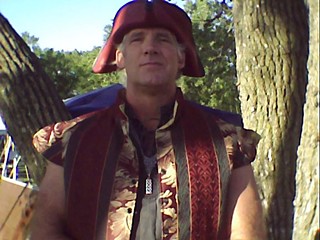Shooter Had "Hate in His Heart"
McQuilliams a "homegrown American extremist"
By Chase Hoffberger and Michael King, Fri., Dec. 5, 2014
At 2:18am, shortly after the bars closed Friday morning, Steve McQuilliams began firing at the federal courthouse, then (apparently) a nearby bank, then the Mexican Consulate (which he also attempted to set afire), then the Austin Police Department headquarters, where he was shot and killed with a handgun by APD Sergeant Adam Johnson, at 2:32am. That was Johnson's only shot, and he managed to make the most of it. From where Johnson was standing near headquarters, he hit McQuilliams more than 300 feet away, firing one-handed while using his other arm to hold the reins of two horses.
Within 14 minutes, an unlikely and jarring attack on some of the city's most prestigious buildings had begun and ended. Immediately, countless questions commenced: Who was Steve McQuilliams? Why did he choose to shoot up four buildings in darkness after a national holiday? And what would have happened to the city if Sgt. Johnson hadn't stopped him?
On Monday at 2pm, Police Chief Art Acevedo gathered with Austin Mayor Lee Leffingwell, members of the FBI, Mexican consul general Rosalba Ojeda, and Acevedo's executive staff to recount investigators' findings in the three days immediately following the shooting. Acevedo described the shooter's background and confirmed many speculations raised in the immediate wake of Friday's events.
Larry Steven McQuilliams, 49, was a "loner," reported his neighbors at the South Creek Apartments in Barton Hills, though not one of those same neighbors suspected him prone to serious violence. He never carried a gun, they told police, though some saw him with "martial arts swords" on occasion. Since the Eighties, he had split his time between Austin and the Midwest, moving back from Kansas City and into his apartment on Hollow Creek last April.
He obtained a rap sheet in both locations. In 1988, he was arrested for possession of marijuana in Kansas, and stopped on a DWI in December of that same year. Four years later in Travis County, in Oct. 1992, he was arrested for aggravated robbery of an armored vehicle at a First State Bank (later dismissed). He was charged by federal authorities for using a firearm to commit a crime one month later. In 1993, he was charged and convicted of interfering with commerce by robbery, as well as use of a firearm, and spent time in federal prison. He was released in June 2000.
More pertinent to the shooting spree, Acevedo noted, was McQuilliams' growing involvement in "an ultra-conservative Christian movement that, when we really dig into cursory reviews, are anti-biracial families, anti-Semitic, and anti-gay." Indeed, as the chief tweeted shortly after the presser, McQuilliams was considered a "High Priest" of the "Phineas Priesthood," a Christian identity movement that scoffs at all forms of race-mixing, homosexuality, and other perceived-to-be-liberal tendencies. "This guy was an extremist," said Acevedo, who added that a copy of Vigilantes of Christendom, a history of the Phineas Priesthood, along with multiple magazines of ammunition, was found in the white van he rented from Avis Rent-a-Car on West 35th Street. "Hate was in his heart."
Indeed, though McQuilliams left no letter behind (save for the words "Let me die" written in marker on his chest and a stack of clothing marked "funeral clothes" in his apartment), FBI special agent Chris Combs said in interviews that he had a rooted motive. "He could not find employment," Combs said. "He was also upset that – in his eyes – many immigrants had more services afforded to them than he had afforded to him."
On Thanksgiving night he wore kneepads, a tactical weight-bearing vest, a CamelBak backpack filled with water, and carried a map with 34 potential targets: the consulate, the courthouse, APD headquarters, two churches, as well as a series of government buildings and financial institutions. He had IEDs (improvised explosive devices) made from propane tanks and fireworks that he unleashed upon the consulate and planned to throw elsewhere, though none of them detonated. Otherwise, police determined that he used two different weapons: an M&P15 .22-caliber long rifle and an Arsenal model SLR 95 rifle Acevedo described as "very similar to an AK-47."
Two days before the shooting, McQuilliams posted a song by Audioslave – "Set It Off" – to Facebook and shortly before he drove Downtown Friday morning, he changed his profile photo to a Tarot card: "The Hierophant." Some time earlier, he had posted a photo and quote of the Dalai Lama (common on pro-gun websites) defending the principle of self-defense.
Although McQuilliams targeted government buildings, media reports have been reluctant to use the term "terrorism" – the use of violence as an extreme form of political action. The reticence is similar to the coverage of the 2010 Joseph Stack suicide airplane attack on the IRS building in North Austin, although in that instance Stack did leave a manifesto attempting to justify his actions.
Acevedo was more apt to use the term, saying at a Friday press conference: "It's important for people to realize that the men and women in this profession are [the public defense] when it comes to any type of threat, from terrorists or the common criminal."
On Monday, at the conclusion of his press conference, he circled back to the term. "He's a homegrown American extremist," he said. "Terrorists come in all kinds of colors, ethnicities, and religions. This man ... by no means can you call him anything but an extremist. He's an American terrorist trying to terrorize our people."
Got something to say on the subject? Send a letter to the editor.













